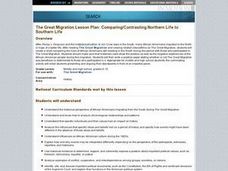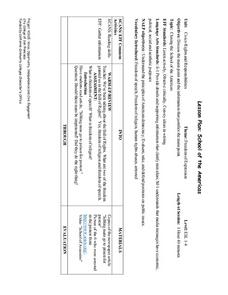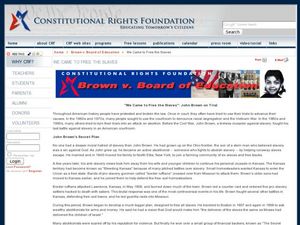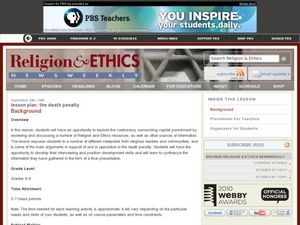National Endowment for the Humanities
NAACP’s Anti-Lynching Campaign in the 1920s
Students investigate the anti-lynching campaign of the NAACP in the 1920's. In this human rights instructional activity, students prepare for and participate in a simulated debate of the Dyer Anti-Lynching Bill that was presented to...
National Endowment for the Humanities
NAACP's Anti-Lynching Campaign in the 1930s
Students examine the anti-lynching campaign sponsored by the NAACP in the 1930's. In this social justice lesson, students study the history of the anti-lynching campaign and determine why it was not successful. Students conduct research...
Curated OER
Comparing/Contrasting Northern Life to Southern Life
Students compare and contrast the lives of African Americans who moved North vs. those who stayed in the South during the era of Jim Crow Laws.
Curated OER
Classifying Rights From Various Constitutions
Students examine classification categories of rights: liberty, security, cultural and group rights using worksheets. They analyze the constitutions of five countries of the Pacific Rim while looking at the rights that are included in them.
Curated OER
What Makes Us Free?: Maine's Declaration of Rights
Students analyze Maine's Declaration of Rights. They review state constitutions and declaration of rights and their importance. They analyze a section of Maine's Declaration of Rights and crete their own declarations of rights. They...
Curated OER
School Of The Americas
Pupils investigate the concept of The Bill Of Rights in order to review the freedom of speech and religion. They read an article in order to establish a context. The lesson plan continues as students research some cases of free speech...
Curated OER
The Adarand Case: Affirmative Action and Equal Protection
Eleventh graders examine the Adarand case. In this American Government lesson, 11th graders create a list of reasons for each affirmative action program. Students develop a defense on certain issues and present it to the class.
Curated OER
Three Visions for African Americans
Students consider the plight of African Americans in post-Reconstruction America. In this African American history lesson, students discover the visions of African American leaders Booker T. Washington, W. E. B. Du Bois, and Marcus...
Curated OER
"We Came to Free the Slaves": John Brown on Trial
Students explore the plight of John Brown to fight slavery. In this Brown vs. Board of Education lesson, students listen to a lecture regarding Brown's work to free slaves through rebellion. Students participate in classroom discussion...
Curated OER
The Death Penalty
Eleventh graders perform a study of the rights guaranteed by the Bill of Rights and focus on the protection against cruel and unusual punishment in the Eighth Amendment as it relates to the death penalty. Prior to formulating a...
Curated OER
The Taxpayer's Rights
Students examine rights of taxpayers and procedures the IRS uses to process tax returns
Curated OER
Representation of the Common Citizen From Declaration of Independence to Present
Students create working definition of common citizen, and investigate and discuss important sections of Declaration of Independence, Articles of Confederation, U.S. Constitution, Bill of Rights, and other Amendments. Students demonstrate...
Curated OER
A Time for Justice
Young scholars explain the protections and privileges of individuals and groups in the United States.
Curated OER
Jackie Robinson, Civil Rights Advocate
Students examine the life of Jackie Robinson and the ways in which he and they can influence government policy.
Curated OER
Government: War Powers Limitations
Students examine historic examples of authority during wartime. They interpret the Fifth Amendment. They debate the merits of the Patriot Act.
Curated OER
Judicial Review
Students visit the Missouri Bar Civics Library to examine the process of judicial review. After completing a worksheet, they discuss the questions to determine what they learned, what more they would like to know, and how the...
Curated OER
Freedom to Worship
Fifth graders read the biographies of seven colonists and determine their position on the freedom of religion. They conduct a panel discussion of seven personalities and debate the religious freedom in America.
Curated OER
What is Meant by Returning to Fundamental Principles?
What did the Founding Fathers mean by the importance of continually returning to fundamental principles? Your young historians will analyze a series of quotations illustrating the fundamental ideals and principles of the United States...
Curated OER
Deutschland und die Europäische Union (Germany and the European Union)
Introduce your language students in German class to the European Union, including the historic developments, the current structure, and some of the political and social principles behind it with this instructional activity. In small...
Curated OER
From The Great War To The Great Depression
Discover details about 1920's America. In this American history lesson, students read From the Great War to the Great Depression. Students then research famous Americans from the time period and present their findings to their classmates.
Judicial Branch of California
Constitution Hall of Fame
Using a tableau activity, class members consider who they want to include in a Hall of Fame to honor the framer of the Constitution. Other activities include using a tableau to act out the various sections of the Constitution and related...
Curated OER
Promoting the Common Good
Students participate in a service learning activity regarding universal human rights. In this service learning activity, students craft posters that illustrate guaranteed rights that all people should possess.
Curated OER
VA Statute for Religious Freedom, III
Students analyze the Virginia Statute for Religious Freedoms and consider its implications. In this governing principles lesson, students explore primary and secondary sources regarding the document penned by Thomas Jefferson.
Curated OER
Concealed weapons bill on target in Ohio
Students research concealed gun legislation in the various states and create a chart for the class that shows the similarities and differences between what has passed and what has failed.

























